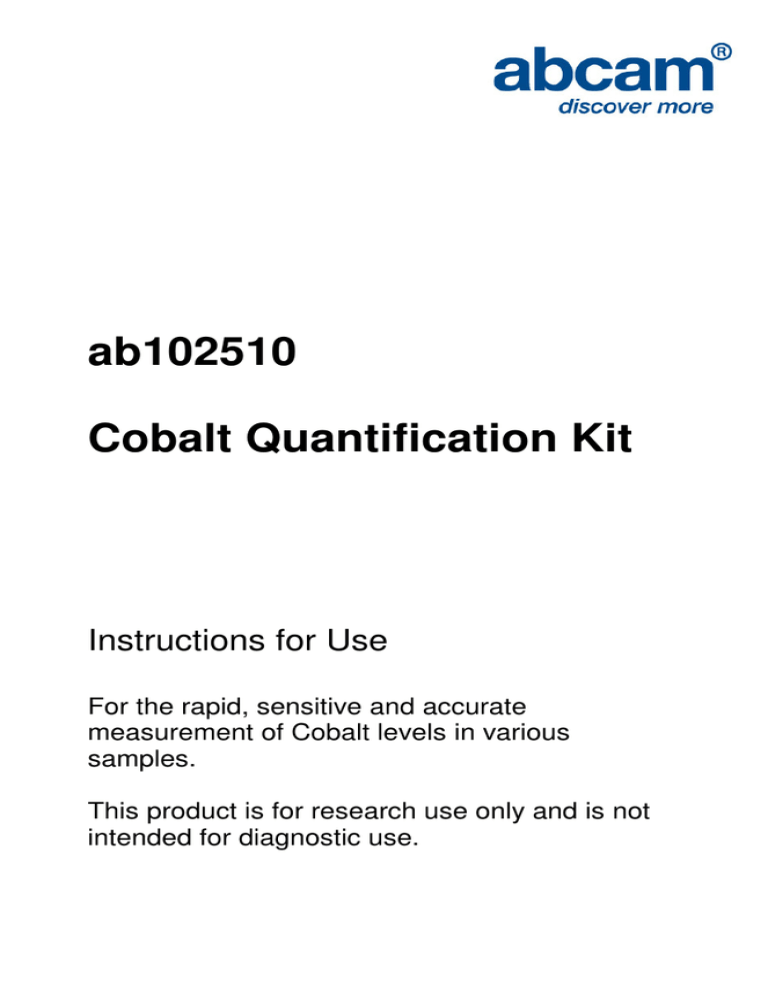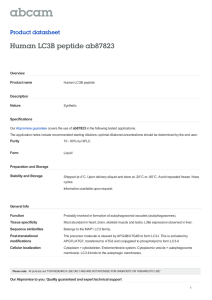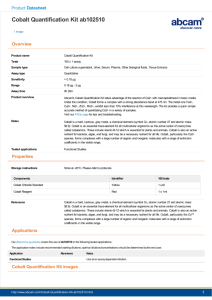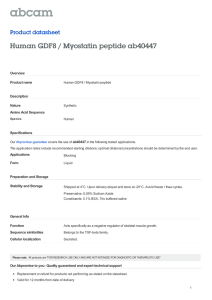
ab102510
Cobalt Quantification Kit
Instructions for Use
For the rapid, sensitive and accurate
measurement of Cobalt levels in various
samples.
This product is for research use only and is not
intended for diagnostic use.
1
Table of Contents
1.
Overview
3
2.
Protocol Summary
4
3.
Components and Storage
5
4.
Assay Protocol
6
5.
Data Analysis
7
6.
Troubleshooting
9
2
1. Overview
Cobalt is a hard, lustrous, grey metal, a chemical element
(symbol Co, atomic number 27 and atomic mass 58.9). Cobalt is an
essential trace-element for all multicellular organisms as the active
center of coenzymes called cobalamins. These include vitamin B-12
which is essential for plants and animals. Cobalt is also an active
nutrient for bacteria, algae, and fungi, and may be a necessary
2+
nutrient for all life. Cobalt, particularly the Co
species, forms
complexes with a large number of organic and inorganic molecules
with a range of extinction coefficients in the visible range.
Abcam's Cobalt Quantification Kit takes advantage of the reaction of
2+
Co
with mercaptoethanol in basic media. Under the condition,
Cobalt forms a complex with a strong absorbance band at 475 nm.
2+
2+
2+
2+
2+
The metal ions Fe , Cu , Ni , Zn , Mn , exhibit less than 10%
interference at this wavelength. The kit provides a quick simple
accurate method of quantitating Co
2+
in a variety of samples.
3
2. Protocol Summary
Sample Preparation
Standard Curve Preparation
Add Cobalt Reagent
Measure Optical Density
4
3. Components and Storage
A. Kit Components
Item
Cobalt Reagent
Cobalt Standard (1 µmol; Lyophilized)
Quantity
15 mL
1 vial
* Store kit at room temperature, keep tightly capped.
COBALT REAGENT: Ready to use as supplied. Store at room
temperature.
COBALT STANDARD: Dissolve in 1 ml dH2O to generate a 1 mM
solution. Store at room temperature.
B. Additional Materials Required
•
Microcentrifuge
•
Pipettes and pipette tips
•
Colorimetric microplate reader
•
96-well plate
•
Orbital shaker
5
4. Assay Protocol
1. Sample Preparation:
Sample Cobalt concentrations can vary over a rather wide range
Take samples between 2-200 µl and adjust the well volume to
200 µl with water.
For unknown samples, we suggest testing several different
amounts of sample to ensure the readings are within the standard
curve
2. Standard Curve Preparation:
Add 0, 10, 20, 30, 40, 50 µl of the 1 mM Cobalt Standard to a
series of wells. Adjust volume to 100 µl/well with water to
generate 0, 10, 20, 30, 40 and 50 nmol per well of the Cobalt
Standard.
3. Development:
Add 10 µl of the Cobalt Reagent to each well containing Cobalt
Standard or samples. Mix well. Incubate at room temperature for
10 minutes.
4. Measure OD at 475 nm in a microplate reader.
6
5. Data Analysis
Correct background by subtracting the zero Cobalt Standard from all
readings.
Plot standard curve nmol/well vs. standard readings. Apply sample
readings to the standard curve to get the amount of Cobalt in the
sample wells.
The Cobalt concentration in the test samples:
Concentration = Ay / Sv (nmol/µl, or µM)
Where:
Ay is the amount of Cobalt (nmol) in sample well from the standard
curve.
Sv is the sample volume (ml) added to the sample well.
Cobalt molecular weight: 58.9 g/mol.
7
Cobalt Standard Curve: Assays were performed following the kit
protocol.
8
6. Troubleshooting
Problem
Reason
Solution
Assay not
working
Assay buffer at
wrong temperature
Assay buffer must not be chilled
- needs to be at RT
Protocol step missed
Plate read at
incorrect wavelength
Unsuitable microtiter
plate for assay
Unexpected
results
Re-read and follow the protocol
exactly
Ensure you are using
appropriate reader and filter
settings (refer to datasheet)
Fluorescence: Black plates
(clear bottoms);
Luminescence: White plates;
Colorimetry: Clear plates.
If critical, datasheet will indicate
whether to use flat- or U-shaped
wells
Measured at wrong
wavelength
Use appropriate reader and filter
settings described in datasheet
Samples contain
impeding substances
Unsuitable sample
type
Sample readings are
outside linear range
Troubleshoot and also consider
deproteinizing samples
Use recommended samples
types as listed on the datasheet
Concentrate/ dilute samples to
be in linear range
9
Samples
with
inconsistent
readings
Unsuitable sample
type
Samples prepared in
the wrong buffer
Samples not
deproteinized (if
indicated on
datasheet)
Cell/ tissue samples
not sufficiently
homogenized
Too many freezethaw cycles
Samples contain
impeding substances
Samples are too old
or incorrectly stored
Lower/
Higher
readings in
samples
and
standards
Not fully thawed kit
components
Out-of-date kit or
incorrectly stored
reagents
Reagents sitting for
extended periods on
ice
Incorrect incubation
time/ temperature
Incorrect amounts
used
Refer to datasheet for details
about incompatible samples
Use the assay buffer provided
(or refer to datasheet for
instructions)
Use the 10kDa spin column
(ab93349)
Increase sonication time/
number of strokes with the
Dounce homogenizer
Aliquot samples to reduce the
number of freeze-thaw cycles
Troubleshoot and also consider
deproteinizing samples
Use freshly made samples and
store at recommended
temperature until use
Wait for components to thaw
completely and gently mix prior
use
Always check expiry date and
store kit components as
recommended on the datasheet
Try to prepare a fresh reaction
mix prior to each use
Refer to datasheet for
recommended incubation time
and/ or temperature
Check pipette is calibrated
correctly (always use smallest
volume pipette that can pipette
entire volume)
10
Problem
Reason
Solution
Standard
curve is not
linear
Not fully thawed kit
components
Wait for components to thaw
completely and gently mix prior
use
Pipetting errors when
setting up the
standard curve
Incorrect pipetting
when preparing the
reaction mix
Air bubbles in wells
Concentration of
standard stock
incorrect
Errors in standard
curve calculations
Use of other
reagents than those
provided with the kit
Try not to pipette too small
volumes
Always prepare a master mix
Air bubbles will interfere with
readings; try to avoid producing
air bubbles and always remove
bubbles prior to reading plates
Recheck datasheet for
recommended concentrations of
standard stocks
Refer to datasheet and re-check
the calculations
Use fresh components from the
same kit
For further technical questions please do not hesitate to
contact us by email (technical@abcam.com) or phone (select
“contact us” on www.abcam.com for the phone number for
your region).
11
12
13
14
UK, EU and ROW
Email: technical@abcam.com
Tel: +44 (0)1223 696000
www.abcam.com
US, Canada and Latin America
Email: us.technical@abcam.com
Tel: 888-77-ABCAM (22226)
www.abcam.com
China and Asia Pacific
Email: hk.technical@abcam.com
Tel: 108008523689 (中國聯通)
www.abcam.cn
Japan
Email: technical@abcam.co.jp
Tel: +81-(0)3-6231-0940
www.abcam.co.jp
15
Copyright © 2012 Abcam, All Rights Reserved. The Abcam logo is a registered trademark.
All information / detail is correct at time of going to print.



![Anti-DR4 antibody [B-N28] ab59481 Product datasheet Overview Product name](http://s2.studylib.net/store/data/012243732_1-814f8e7937583497bf6c17c5045207f8-300x300.png)

